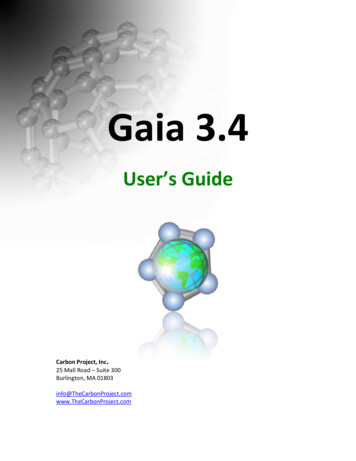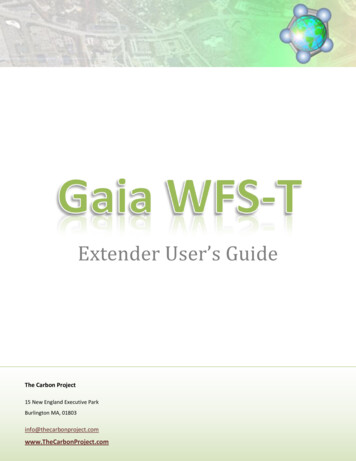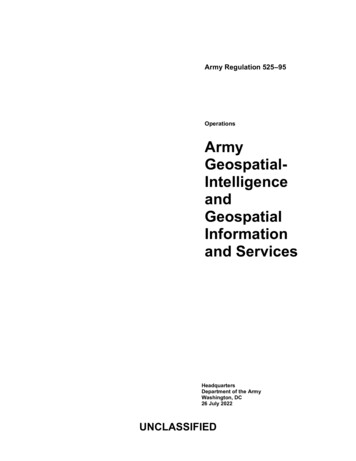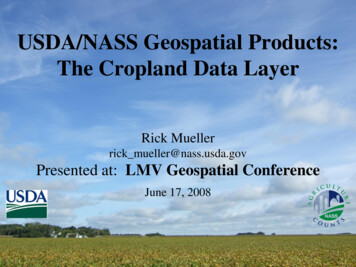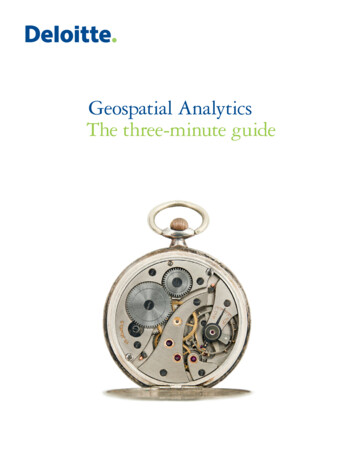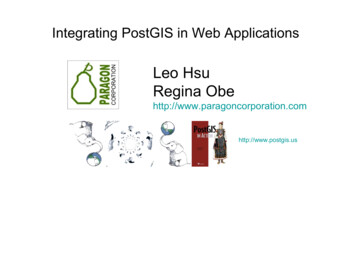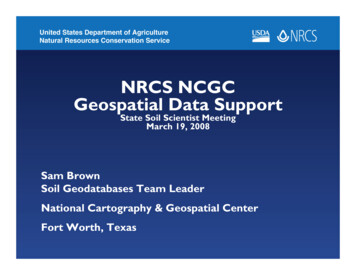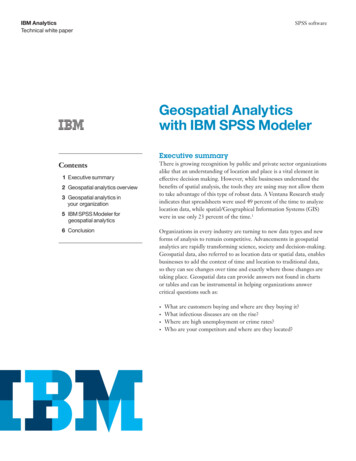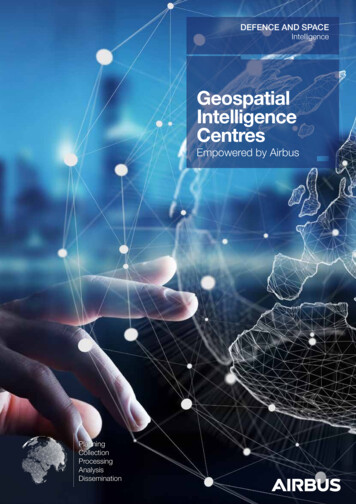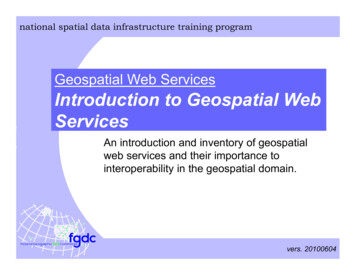
Transcription
national spatial data infrastructure training programGeospatial Web ServicesIntroduction to Geospatial WebServicesAn introduction and inventory of geospatialweb services and their importance tointeroperability in the geospatial domain.vers. 20100604
Introduction to Geospatial Web ServicesLearning ObjectivesAfter completing this module the student can:Explain the difference between a website, a webservice, and a geospatial web serviceDifferentiate between types of geospatial web servicesand how they are usedExplain the purpose of the Open GeospatialConsortium (OGC)national spatial data infrastructure training program1
Introduction to Geospatial Web ServicesDifferences between a Website & Web ServicesWebsitesProvide HTML pages and formsfor human users to navigate andperform functions Searching, Shopping, InteractionFront end user interfacesthrough the browserExample: www.google.comnational spatial data infrastructure training programWeb ServicesNOT websitesOperations that can be called toreturn informationInvoked automatically through aprogramPublicly available andstandardized for use by allprogrammersExample:2
Introduction to Geospatial Web ServicesTypes of Geospatial Web ServicesWeb based services with a focus ongeospatial information1.Data Discovery: Provide search anddiscovery to geospatial data and services2.Data Visualization – Provide visualizationimages of the actual geospatial data3.Data Access – Provides access to theactual geospatial datanational spatial data infrastructure training program3
Introduction to Geospatial Web ServicesGeospatial Web Service TypesUserApplicationsGeospatialWeb ional spatial data infrastructure training programCoverages4
Introduction to Geospatial Web ServicesGeospatial Web Service ExampleRequest to a web service for an image of a mapWeb Map Service (WMS)http://100.200.128.70/wms/process.cgi?REQUEST GetMap&FORMAT image/gif&WIDTH 640&HEIGHT 480&LAYERS relief,bound&SRS EPSG:4326&BBOX -137,14,-50.,52&VERSION 1.1.1national spatial data infrastructure training program5
Introduction to Geospatial Web ServicesGeospatial Web Service ExampleRequest to a web service for attributeinformation for a specific pointWeb Feature Service (WFS)http://100.200.128.70/geoserver/wfs?request GetFeature&version 1.0.0&typeName massgis:GISDATA.TOLLBOOTHS POLYnational spatial data infrastructure training program6
Introduction to Geospatial Web ServicesGeospatial InteroperabilityAbility for different systems toexchange/use geospatial information Web services provide interoperabilityInteroperability drives costs downand productivity up How many hours does it take totransform, translate and understand“free” data you download from the web? Are you even certain it is “fresh” after allthat processing?Spatial Data Infrastructures (SDI’s)use web services to access andpublish data, services and Figure 1: “Stove Pipe” SystemsClient1Server1Server2Client2Server3 Need to be interoperable with other SDIsystems world wideFigure 2: Network of Systemsnational spatial data infrastructure training program7
Introduction to Geospatial Web ServicesThe Open Geospatial ConsortiumVision:Develops standards forgeospatial web servicesMission:A world in which everyonebenefits from geographicinformation and servicesmade available acrossany network, application,or platformnational spatial data infrastructure training program8
Introduction to Geospatial Web ServicesOGC Provides InteroperabilityOGC Specifications are agreed upon by a broadconstituency of the geospatial community andare supported by many software vendorsOGC links geographic data with mainstreamInformation Technology (IT)Vendor implementation in products enables thedirect access and use of data produced byprograms from many vendorsnational spatial data infrastructure training program9
Introduction to Geospatial Web ServicesExample MembersIntegratorsLockheed Martin, QuenitQ, SAIC, BAE Systems, Boeing, GeneralDynamics, Computer Sciences Corporation, SchlumbergerInformation Solutions Major Hardware and Software CompaniesSun Microsystems, Oracle, HP, Microsoft Developers of GeoSpatial Technologies and ServicesIntergraph, AutoDesk, ESRI, LaserScan, MapInfo, SICAD, GENetwork Solutions, PCI Geomatics, Leica Geosystems,Government agencies that depend on geoprocessingUnited Nations, National Government Agencies from: UnitedStates, Canada, United Kingdom, France, Germany, Australia,Japan, Republic of Korea; Sub-National Governments:California,Consellería de Medio Ambiente (Spain), NRW .OthersContent Providers, Power, Universities, Consultants, Startups national spatial data infrastructure training program10
Introduction to Geospatial Web ServicesOGC and Standards OrganizationsOGC collaborates and work closely with:International Organization for Standardization (ISO)TC 211 and 204World Wide Web Consortium (W3C)Internet Engineering Task Force (IETF)OASISAutomotive Mobile Information ConsortiumOpen Mobile AllianceAnd others national spatial data infrastructure training program11
Introduction to Geospatial Web ServicesApproved OGC SpecificationsService TypeNameSDI Suite 1.0Data DiscoveryCatalog Service with CSDGM MetadataVersion 2.0 Z39.50 ProtocolData VisualizationWeb Map ServiceVersion 1.1.1Style Layer DescriptorWeb Map ContextData AccessWeb Feature ServiceVersion 1.0Web Coverage ServiceVersion 1.1Geographic Markup LanguageVersoin 2.1.2Filter EncodingVersion 1.1national spatial data infrastructure training program12
Introduction to Geospatial Web ServicesA Concrete Example on Non-InteroperabilityTerraServer - http://terraserver.microsoft.comMapQuest - http://www.mapquest.comEPA - l spatial data infrastructure training program13
Introduction to Geospatial Web ServicesA Concrete Example of Interoperabilitynational spatial data infrastructure training program14
Introduction to Geospatial Web ServicesWeb Mapping Interoperability ExampleCentral America demonstration developed for Global Spatial DataInfrastructure (GSDI) meeting in Cartagena, Colombia 2001 todemonstrate capabilities of WMS servers and clientData Servers Established:FGDC – Reston DCW BoundariesRoadsCitiesShaded ReliefEROS Data Center – South Dakota El Salvador Roads1 & 2CitiesDepartmentsUNITEC – Honduras RiversLakesLand UseBase Mapnational spatial data infrastructure training program15
Introduction to Geospatial Web Servicesnational spatial data infrastructure training program16
Introduction to Geospatial Web Servicesnational spatial data infrastructure training program17
Introduction to Geospatial Web Servicesnational spatial data infrastructure training program18
Introduction to Geospatial Web Servicesnational spatial data infrastructure training program19
Introduction to Geospatial Web Servicesnational spatial data infrastructure training program20
Introduction to Geospatial Web ServicesWhat Does All This Do for You?‘Near instant’ data interoperabilityAccess and exploit a wide variety of spatial data on-demandNo more time spent translating files to your format or projectionSupports web based services architectureGet your GIS over the web. Choice of web-based toolsLocate information across a distributed environment using different vendorapplications, different projectionsNo more data configuration managementGet your answer from the latest data when you need itReduce data maintenance costs. Access and maintain only the data youcare aboutnational spatial data infrastructure training program21
Introduction to Geospatial Web ServicesSummaryThis is the conclusion of: Introduction toGeospatial Web Services.You should be able to:Explain the difference between a website, a webservice, and a geospatial web serviceDifferentiate between types of geospatial web servicesand how they are usedExplain the purpose of the Open GeospatialConsortium (OGC)national spatial data infrastructure training program22
Introduction to Geospatial Web ServicesAdditional LessonsThe FGDC invites you to gram/online-lessonsfor additional lessons.national spatial data infrastructure training program23
Introduction to Geospatial Web Services. 3. Types of Geospatial Web Services. 1. Data Discovery: Provide search and discovery to geospatial data and services 2. Data Visualization - Provide visualization images of the actual geospatial data 3. Data Access - Provides access to the actual geospatial data. Web based services with a focus on
